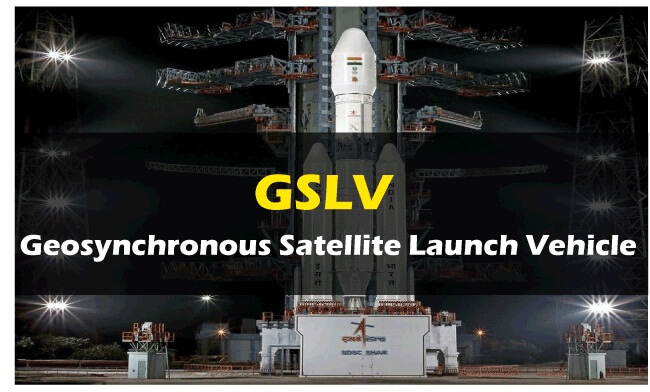GSLV Full Form
GSLV Full Form: GSLV (Geosynchronous Satellite Launch Vehicle) is a launcher vehicle used to launch satellites, spacecraft and other space objects to Geosynchronous Transfer Orbit. It is made by ISRO (Indian Space Research Organization).

However, India has two launchers, PSLV (Polar Satellite Launch) that is for lower earth orbit and GSLV (Geosynchronous Satellite Launch Vehicle) which is for Geostationary Transfer Orbit. The project of GSLV was started in 1990 by Indian Space Research Organization (ISRO), for making India more capable in that respective area.
GSLV is the modified version of PSLV, as most of the components used in GSLV, like Solid Rocket Booster and Liquid Fueled Vikas Engine are from PSLV, and still due to modification it is more powerful, and capable of launching heavier communication and multipurpose satellites.
Moreover, the first flight of GSLV Mk I which was launched on 8th April 2001 was a failure, as it failed to reach its intended orbit. But the launcher proved itself operational, after the successful launch of a second flight GSAT – 2 satellite.
When we go through its launch history, we see that there were several launches from 2001 to 2014, in which most of the launches were successful, whereas, some of them were failure, as we can see in following data:
Variant Launches Successes Failures Partial Failures
GSLV MK.I 6 2 2 2
GSLV MK. II 7 6 1 0
Total as of 13 8 3 2
March 2021
Further, Geosynchronous Satellite Launch Vehicle is a three stage launcher vehicle;
First stage: GS1 is a 138 ton S139 Solid Rocket Motor with four liquid engines. It generates a maximum thrust of 4700 kilo Newton.
Second stage: GS 2 is of Liquid Rocket Engine which is known as Vikas Engine. It generates a maximum thrust of 800 kilo Newton.
Third stage: CUS is a cryogenic engine, which uses liquefied oxygen and hydrogen as fuel. Earlier Russian KVD- IM engine was used for this stage but it is replaced by the MK.2 version which is Indian built CE7.5 engine.
Now, Geosynchronous Satellite Launch Vehicle Mark III (GSLV MK III), is also called Launch Vehicle Mark3 (LVM3). The payload capacity of GSLV MK III is higher than GSLV MKII.
The launch history of GSLV MK III is:
Total launches 4
Success 4
Failure 0
First flight 18 December 2014 (suborbital)
5 June 2017 (orbital)
Last flight 22 July 2019
Notable payloads CARE, Chandrayan-2
Launch sites Satish Dhawan Space Centre SLP,
Andhra Pradesh, India
Status Active
Our achievements from GSLV MKIII are as; first it launched CARE which was India’s Space Capsule Recovery Experiment Module. After it Chandrayaan-2 was launched, which was the second lunar mission of India. And now it is planned to use it, for carrying Gaganyaan, which will be the first crewed mission under Indian human spaceflight programme.
We can know through the words of A.S kiran kumar (Chairman, Indian space research organisation), that how much important the success of new launcher, GSLV MKIII is:
‘It is indeed a very significant development in the Indian space programme. It gives us a big push. We were short of this capacity for lifting our communication satellites. We had to go outside for our launches; and because of (the launch schedules of foreign space agencies) the pace at which we did our projects was getting affected. Cost was another deterrent for pushing things aggressively. By achieving MKIII, we will be able to push confidently and launch many of our communication satellites faster and indigenously. We will do one more launch within a year and establish it systematically’.
(The Hindu)
So, overall we can say that Geosynchronous Satellite Launch Vehicle is a great achievement for us as well as very proud of our country.